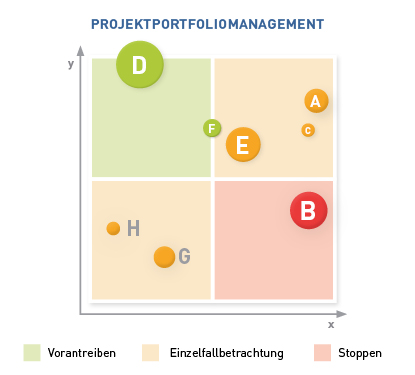03/11/2024 - Articles
Why projects fail - 8 common reasons, 8 solutions
Who hasn't experienced it? You start a new project full of enthusiasm and confidence. The planning has already been successfully completed, the project launch went extremely well and everyone involved is full of enthusiasm and drive. But over time, the mood begins to change and with it the entire project. Work processes go awry as planned, communication becomes rougher and more confusing, collaboration starts to break down. The project threatens to fail. The reasons for the failure of a project can be very diverse, but there are recurring problems. Find out what the 8 most common reasons for project failure are and what you can do about them.
When does a project fail?
The failure of a project can have various facets. In general, a project has failed if the defined project objectives are not met. The most severe form of project failure is project termination.
In addition to project termination, a major delay to the project can also be described as failure. Deadlines and adherence to the schedule are ultimately one of the target dimensions of a project ("magic triangle in project management" with the three target dimensions of time, costs and performance).
Exceeding the project budget and the estimated costs of a project can also be seen as a failure. The project would no longer be economically viable and would jeopardize the budget available for other projects and negatively impact other projects.
Even if the service agreed in the specifications is not provided in full, for example if functions in development projects cannot be realized, the project is considered a failure. This means that the developed product cannot be used as intended.

The main thing is that everyone is happy! - Success is a matter of definition
Depending on which target dimension is assessed as critical for the success of the project as part of the target definition, a project can also be considered successful if individual factors are not met. If, for example, there is an explainable and understandable delay in the planned project completion, but all stakeholders are extremely satisfied with the service provided, the project can still be rated as successful. How much leeway is granted here depends heavily on management support and communication with the client.
In practice, stakeholder satisfaction is often affected by failure to meet deadlines, budgets or performance targets.
What are the consequences if a project fails?
The consequences of a project being abandoned or otherwise failing can be devastating:
| Financial losses: This may include the wasted investment in resources, time and technology. |
| Waste of resources: The resources invested in the failed project, including labor, technology and materials, are wasted. This hampers the efficiency and profitability of the business. |
| Loss of time: This can lead to delays in other planned activities or projects. |
| Loss of reputation: Customers, investors and other stakeholders lose confidence in the company's ability to successfully implement projects. |
| Employee frustration: Employees who have worked on a failed project may become frustrated, demotivated or demoralized, which can affect employee satisfaction and engagement in the long term. |
| Internal tensions: Blame-shifting and conflict within the team can occur, which can affect collaboration and productivity. |
| Legal consequences: If contracts are not fulfilled or customers make claims for damages, a failed project can have legal consequences. |
Why projects fail: 8 reasons, 8 solutions
1st reason for project failure: Poor or inadequate project preparation
In many cases, the project preparation phase is not given the importance it deserves, whether by the management, the client, the project manager or the project team. The project preparation phase involves reflection, analysis and discussion. The most important thing is to work out why the project should be carried out at all. Requirements are discussed, possible cooperation models are agreed and expectations are formulated.
Extensive project preparation may seem unproductive, especially for managers. This is why it is often dramatically shortened or planning or even implementation is started at the same time. Many companies rush straight into what needs to be implemented and how challenges are to be overcome. The why and the acceptance of all those involved often fall by the wayside.
A lack of clarity regarding the goals and requirements of the project can lead to ambiguities and misunderstandings that jeopardize the project. However, if the goals, expectations and requirements of the project are not clearly defined, it is difficult to measure the progress of the project and ensure that everyone involved is on the same page.

Thorough project preparation is essential if you want your project to be successful. Define clear objectives and requirements to avoid misunderstandings. Identify risks early and plan resources efficiently to keep budget and time under control. Develop a clear communication plan for smooth team and stakeholder management. Consider stakeholder needs to ensure successful collaboration. Well-prepared decision-making and the promotion of team motivation are further benefits.
2nd reason for project failure: Inappropriate project organization form
Choosing the right form of project organization is crucial to the success of a project, as it has a significant influence on structure, collaboration and responsibilities. Clearly defined roles and responsibilities lead to more efficient collaboration, while the clear assignment of decision-making powers minimizes conflicts. The type of organizational form also influences resource management, flexibility and adaptability to changing requirements as well as the motivation of team members. A well-structured project organization form avoids overload and enables efficient use of resources.
The wrong choice of organizational form can lead to serious problems and can promote many of the risks of project failure mentioned here, including communication problems, decision blockages, inadequate resource allocation, conflicts, lack of adaptability and lack of identification with the project.These challenges affect efficiency, team dynamics and motivation, which cumulatively contribute to the failure of the project. A precise analysis of the project parameters and a well-founded selection of the organizational form are therefore crucial to minimize these risks.

The selection of the appropriate organizational form depends on the type of project, the scope and the people involved. Autonomous, matrix and staff line project organizations offer different advantages depending on the project requirements. Decisive factors for the choice are the project size, need for innovation, number of participants, flexibility and adaptability. A careful analysis of these parameters is crucial in order to choose an organizational form that contributes to successful project execution and the company's overall strategy.
3rd reason for project failure: incomplete and unrealistic planning
An important factor for project success is thorough planning and adherence to time and cost frameworks. If these are not realistic or important factors are not taken into account, delays and additional costs can occur. If new requirements are added during the course of the project, this will inevitably lead to time and/or budget overruns.
The project objective and the project scope, i.e. a common understanding of what is to be delivered as part of the project or increment, must be fully recorded at the beginning of the planning phase when the work breakdown structure is created and all necessary steps must be taken into account accordingly. The scope of the items or services to be delivered is always based on the project objective and the individual measures and functions are prioritized within the project plan.
The planning must include all necessary content and work packages that are required for subsequent implementation. It is important to pay attention to every small subtask. Underestimating the effort involved will lead to an unrealistic schedule.

When planning a project, it is crucial to realistically estimate the effort and costs involved. Analyze requirements thoroughly, evaluate risks and use empirical values. For precise estimates of each task, you should consult experts and plan buffers for the unforeseen. If there are uncertainties in unfamiliar task areas, it is helpful to ask people from this area for their assessment. This transparent communication strengthens employee commitment and promotes realistic expectations. A balanced approach based on clear analysis and experience is the key to successful project management.
4th reason for project failure: lack of resources and resource planning
A lack of resources and inadequate resource planning pose significant risks to project success, as budget, personnel, time, space and work equipment form the foundation of every project. Overloaded project teams or a lack of crucial resources can significantly impair successful project implementation. However, it is not only important to provide sufficient resources, but also to ensure that the right skills are available at the right time.
The biggest danger is to misjudge resource utilization. Often, planned team members are already tied up with other projects or line activities. This can lead to half-hearted work, unfinished tasks and significant delays. Poor resource planning that does not clearly define which people with which skills are needed at what time and with what scope of work is particularly problematic.
Excessive team size does not necessarily lead to better and faster output. Group dynamic processes can become risks as the team is more preoccupied with internal matters, conflicts arise more easily and maintaining team dynamics requires additional attention and time.

Prevent potential problems caused by scarce resources and inadequate resource planning by making an early and accurate forecast of the required resources. Continuously monitor resource utilization during the project in order to make timely adjustments. Place particular emphasis on detailed project planning with clear definitions of the required resources and time frames. Focus on selecting a small number of strategically important projects. Project portfolio management provides a useful method for identifying and focusing on the right projects.
5th reason for project failure: inadequate risk management
Experience has shown that there is no project in which everything goes according to plan down to the last detail. Therefore, another important factor for project success is a mature risk management system. If risks are not identified at an early stage and dealt with adequately, unexpected problems can arise that jeopardize the project. However, with sophisticated risk management and ongoing project controlling, you are well prepared for these situations, recognize problems before they arise and have the appropriate countermeasures ready to hand.

Identify potential risks by brainstorming, interviewing experts and analyzing historical projects. Evaluation criteria such as probability and impact help to prioritize risks. Create a clear risk management plan with concrete measures to minimize or avoid the risks. Regular monitoring and updating of the plan are important in order to react flexibly to changes.Communicate the identified risks and the risk management plan transparently to all those involved. This ensures a well-informed team and improves the chances of a successful project.
6th reason for project failure: Lack of management support
A lack of management support can easily cause a project to falter and ultimately lead to failure. The more management is convinced of the project benefits, the more likely they are to release critical resources in favor of the project. Finally, management plays a critical role in allocating resources, setting priorities and creating a supportive environment for the project team.
However, if management is not fully behind a project, uncertainty and resistance can arise at all levels. There is a lack of clear guidelines, budgets may be cut and team members' motivation may suffer. In the worst case scenario, management knows nothing about the project and the smallest obstacle in the course of the project blows up the entire project planning.
Without strong support from the top, it will be difficult to overcome obstacles and complete the project successfully. Management support is therefore not just a bonus, but a crucial prerequisite for project success. This becomes clear in software implementation projects, for example, where management support plays a key role in choosing the right implementation strategy as a corporate factor that can be influenced.

To ensure management support for a project, clear communication of objectives and benefits is crucial. Create a compelling business case by relating project benefits to business objectives, plan resources realistically, keep management regularly updated and demonstrate solution orientation. A committed and motivated team and the integration of management feedback promote trust and project success.
7th reason for project failure: Lack of leadership and confusion of competencies
The impact of a lack of leadership and unclear decision-making authority on project success can be devastating. The worst decisions are those that are not made in the first place, and this often leads to a lack of direction and clarity in the course of the project. One cause can be a lack of experience on the part of the project manager. Sound theoretical training in the relevant PM methods (IPMA/GPM, PMI, Scrum, etc.) is a basic requirement, but is no substitute for corresponding practical experience as a project manager in similar projects.
The negative consequences are particularly noticeable when there is a lack of decisiveness on the part of managers. Delays become more likely and the project can find itself in a state of uncertainty and stagnation. Lack of leadership and clear decision-making authority can lead to a domino effect where team members are unsure of what actions to take and efficiency is significantly impacted.
Project leaders and teams that are not given the necessary authority and trust from senior management face a significant handicap. The inability to make independent decisions leads to missed opportunities, poorer results and a general lack of clarity on how to successfully complete the project.

To prevent a lack of leadership and unclear decision-making powers, you should act proactively. Demand clear decision-making authority and support, define clear roles and responsibilities within the project organization, establish a clear communication channel and encourage decisiveness. Regular review, adjustment, training and development of decision makers and project team members will help to minimize risk and strengthen the foundations for successful project delivery. If the project manager is still relatively inexperienced, it is advisable to staff the project team with experienced employees.
8th reason for project failure: lack of communication and cooperation
Communication problems, whether internal or external, occur in almost every project. They can be of different natures and varying degrees. Communication breakdowns that can lead to project failure include
- Lack of communication within the project team: if communication and collaboration between stakeholders is not effective, misunderstandings and errors can occur, jeopardizing the project.
- Lack of transparency and timely information: A lack of transparency and delays in passing on information can lead to problems and crises. If relevant information is not passed on in good time, decisions can be made on an uncertain basis.
- Underestimating the importance of communication: Often little value is placed on communication, even if the project manager is methodologically and technically well trained. Important stakeholders may be involved in the project too late or not at all, and they may not be regularly informed about progress.
- Lack of understanding of stakeholder involvement: There can be a lack of understanding about which people should be involved in the project and how. This often leads to affected persons feeling excluded.
Overall, these problems indicate deficits in the communication structure that can impair the flow of information and jeopardize stakeholder engagement.

As a project manager, create a positive working environment in which all team members feel welcome. Set clear and achievable project goals, communicate openly on a regular basis and encourage the exchange of information and ideas. Create an atmosphere of trust in which all team members can freely express their opinions. Assign tasks and responsibilities clearly to avoid misunderstandings and ensure that everyone involved in the project understands the same vision and goals. Organize regular feedback sessions to review the progress of the project and identify problems at an early stage.
Koen Spekreijse, Head of Application and Process Management, Cal Consult
"Since both of our CAL Consult branches use Projektron BCS, it was easy to merge the two branches. Processes can be better standardized, which in turn forms a good basis for quickly launching joint projects, communicating with each other in a targeted manner and thus successfully implementing customer and IT projects."
Prevent project failure right from the start with project management software
You can effectively prevent all eight of these problems that can lead to project failure - be it poor project preparation, incomplete planning, inadequate resource planning, insufficient risk management, lack of leadership or communication problems - by using project management software.
The all-in-one software solution for your project management, Projektron BCS, has the features you need to put your project on the road to success right from the start. Here are some aspects of how Projektron BCS helps you avoid the pitfalls:
| Efficient project preparation: Projektron BCS supports structured and comprehensive project preparation. You can clearly define objectives, specify requirements and coordinate internal and external collaboration models. |
| Realistic project planning: With a wide range of planning tools and wizards for project planning according to all common project management methods, Projektron BCS supports you, even as an inexperienced project manager, in detailed project planning, including realistic estimation of effort and costs. By analyzing requirements, evaluating risks and integrating expert opinions, it enables more precise project planning. |
| Effective resource planning: Projektron BCS provides resource planning capabilities that ensure the right skills are available at the right time. Through early and accurate forecasting of required resources and continuous monitoring, the software can avoid bottlenecks and overloads. |
| Comprehensive risk management: Projektron BCS enables the identification, assessment and management of risks and helps to create clear risk management plans with concrete measures to minimize or avoid risks. |
| Clear leadership and decision-making authority: Projektron BCS creates transparency in terms of roles and responsibilities. It supports clear decision-making authority and promotes decision-making agility by enabling a clear level of communication and effective collaboration. |
| Improved communication and collaboration: The software offers functions for effective communication within the project team. It enables the transparent sharing of information, promotes the exchange of ideas and creates a positive working environment that strengthens collaboration. |
See for yourself and test Projektron BCS now, free of charge and without obligation.

Martin Pfäffli, IT Services & Head of Applications, Stämpfli AG
"One of the most important functions we currently use is project planning and management. With BCS, we can manage projects from start to finish, delegate tasks and schedule people and teams. This helps us to ensure that we always have enough staff available for our projects. We can also control the workload of our employees and avoid bottlenecks and overloads."
If the rescue comes too late: let the project fail
Successful project management requires not only the ability to control projects and prevent them from failing, but also the foresight to abandon them when failure is unavoidable. When this critical point is reached and what an effective exit strategy can look like is discussed in the following sections.
When does it make sense to let a project fail?
Considering a project to have failed should only be considered when all rescue attempts have been unsuccessful and the first signs of failure are already recognizable several weeks before the final collapse.

If the mood in the project team is sinking and the employees are trying to protect themselves from the impending problems, it may be time to accept the failure of the project. In this case, the project manager should develop a viable "exit strategy". While allowing failure to happen is an extreme case, keeping control of the team requires excellent leadership skills.
What makes a good exit strategy?
A good exit strategy is crucial for managing the failure of a project in a transparent and coordinated manner. Even if failure is inevitable, competent project management is expected to recognize developments and pull the ripcord at the right moment. This means communicating transparently and developing a clear exit strategy in good time. A contingency plan should already be drawn up in the planning phase, setting out clear criteria for when the project is considered to have failed.
Root cause analysis and action plans
If the project does fail, it is important to collect and evaluate the causes of the failure as a team. Management will be looking for explanations, so action plans and early warnings should be documented. Opinions within the team may differ, so a clear definition of the criteria for failure is important.
Conclusion: Prevent failure, ensure project success
The successful start of a project can easily end in problems and failure if crucial factors are not taken into account. There are many reasons for project failure, from inadequate preparation and unrealistic planning to resource conflicts and a lack of communication. The consequences are devastating, from financial losses and loss of time to a loss of stakeholder trust.
If we take a closer look at the reasons for failure, it becomes clear: Projects always fail because of people. To prevent risks, careful project preparation, realistic planning, effective resource management, comprehensive risk management, clear leadership and communication are crucial. Early identification and resolution of problems can ensure project success and prevent undesirable consequences. Project management software such as Projektron BCS is invaluable for precisely these challenges, as it provides all project-related data in addition to planning and control tools and offers the project team a central information, collaboration and communication platform for project work.

About the author
As in all other departments at Projektron GmbH, the marketing department also uses the possibilities of Projekteon BCS on a daily basis to support its projects and workflows. Once internal projects have been completed, the process is evaluated in detail, findings are recorded and processes are optimized based on data and experience in order to prevent projects from failing. As an editor in the marketing department, Kai Sulkowski is always up to date with the latest developments and innovations in project management and work organization.
More interesting articles in the Projektron blog

Defining project objectives
Learn why clear project objectives are crucial for success and how to formulate them precisely. Discover different types of objectives, overcome conflicting objectives and use the objective relationship matrix.

Project communication
One of the main reasons for project failure is a lack of project communication - according to a PMI study, communication management in a project is just as important as an accurate cost estimate, a clear definition of project goals and a thorough risk analysis. 3 practical tips for your project communication!

Project portfolio management
What is project portfolio management, why is it needed and what are the tasks of a project portfolio manager? Discover 5 good reasons for project portfolio management and a proven 7-step strategy for your project portfolio management!

Resource planning
Resource planning is a strategically important step in project management. What is a resource plan? What information does it contain? What are the benefits of resource planning in project management? Here's resource planning from A to Z.













